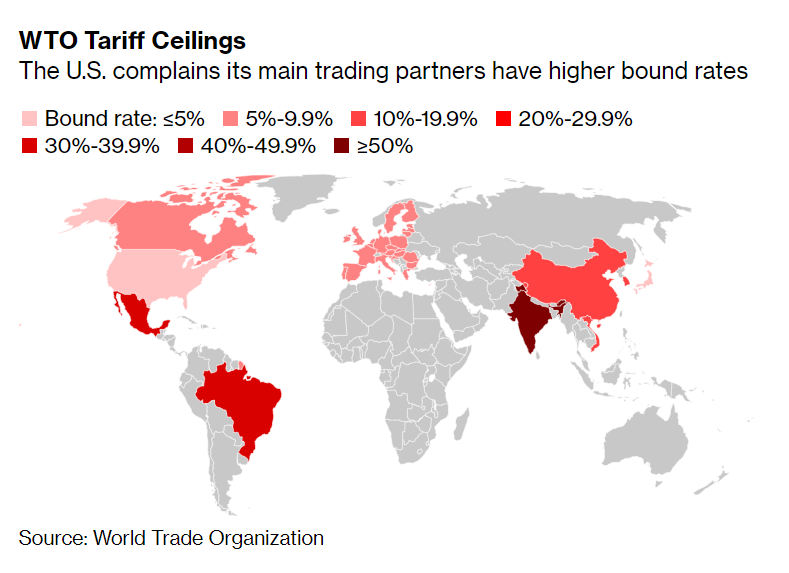A broad renegotiation of America's bound @wto tariffs would be the most significant shift in U.S. trade policy over the past quarter century & would have myriad implications for the WTO's other 163 members.
A brief thread on why this is happening & how this works
1/15 https://twitter.com/bbaschuk/status/1273113623330803716
A brief thread on why this is happening & how this works

1/15 https://twitter.com/bbaschuk/status/1273113623330803716
. @ustraderep says other nations treat the U.S. unfairly because it's bound by higher tariffs & its trading partners are unwilling to lower theirs -- such as EU passenger-car duties and Indian motorcycle tariffs.
Here's what Lighthizer plans to tell lawmakers today
2/15
Here's what Lighthizer plans to tell lawmakers today

2/15
Renegotiating America's bound tariffs could help the White House increase its pressure on various nations and trading blocs with whom the U.S. does not have an existing free-trade agreement, like the EU, India, Brazil and the U.K. (cc: @trussliz)
3/15
3/15
When joining the @WTO each nation prepares its own schedules of concessions, which outline tariff rates and other trade rules by which countries may sell goods and services to the rest of the world.
4/15
4/15
The U.S. average bound rate is now 3.4%, which is among the lowest for major developed countries & has remained virtually unchanged for more than a decade. By comparison, the average bound rates for India are 51% & Brazil’s are 31%.
5/15
5/15
The U.S. president has the authority to trigger a modification of America's @wto bound tariffs under a provision known as Article 28 of the General Agreement on Tariffs and Trade (GATT).
https://bit.ly/2C8X00Y
6/15
https://bit.ly/2C8X00Y
6/15
Art. 28 renegotiation is a relatively normal procedure. Over the past 25 years there have been nearly 50 requests by members to renegotiate their @wto tariff commitments.
The UK & the EU are currently reworking their WTO commitments as part of their Brexit preparations.
7/15
The UK & the EU are currently reworking their WTO commitments as part of their Brexit preparations.
7/15
Every three years nations can reserve their right to begin negotiations to change their bound tariff levels according to a procedure outlined in Art. 28 of the GATT.
The latest triennial period began on Jan. 1, 2018 & will conclude on Dec. 31, 2020.
8/15
The latest triennial period began on Jan. 1, 2018 & will conclude on Dec. 31, 2020.
8/15
Under Art. 28 the US may notify members it intends to raise its bound tariff rates, provide 3 years worth of trade statistics for each renegotiated tariff line & encourage any nation with a substantial trading interest to begin talks to obtain trade concessions in return.
9/15
9/15
Any affected @wto member can ask the US for compensation to address the loss of trade concessions.
Any agreed upon concessions would be granted on a most favored nation basis to all other WTO members.
10/15
Any agreed upon concessions would be granted on a most favored nation basis to all other WTO members.
10/15
While U.S. trade officials say their goal is to reduce all WTO members' tariffs down to zero -- the plan could alternately result in a broad realignment of the world's tariff regime and chaos at customs borders.
11/15
11/15
As @jendeben and I wrote back in February the administration’s strategy is to start with a proposal to renegotiate America’s tariffs with the expectations that the @WTO’s other 163 members would not collectively agree to new multilateral terms.
https://bloom.bg/2BjQXWT
12/15
https://bloom.bg/2BjQXWT
12/15
Considering the lack of consensus on just about anything at the @wto its a fair bet that these talks are doomed to fail.
If and when they do fail, the US would then consider moving forward unilaterally to impose reciprocal tariffs on America’s trade partners.
13/15
If and when they do fail, the US would then consider moving forward unilaterally to impose reciprocal tariffs on America’s trade partners.
13/15
Countries have until the end of the year to try to negotiate compensation for the proposed U.S. tariff changes. Negotiations could also be extended.
If members can't reach an agreement on compensation by then the U.S. can unilaterally impose its new bound tariff levels.
14/15
If members can't reach an agreement on compensation by then the U.S. can unilaterally impose its new bound tariff levels.
14/15
Absent an agreement there is nothing stopping the U.S. from imposing new bound tariff rates under an uncertified @wto schedule.
Any aggrieved nations can retaliate against the U.S. by imposing tariffs or other trade restrictions. (ie. Global Trade War)
15/15
Any aggrieved nations can retaliate against the U.S. by imposing tariffs or other trade restrictions. (ie. Global Trade War)
15/15

 Read on Twitter
Read on Twitter



